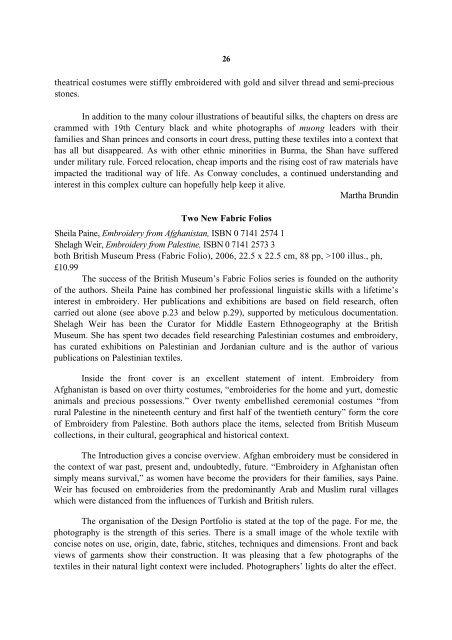download - OATG. Oxford Asian Textile Group
download - OATG. Oxford Asian Textile Group
download - OATG. Oxford Asian Textile Group
- No tags were found...
You also want an ePaper? Increase the reach of your titles
YUMPU automatically turns print PDFs into web optimized ePapers that Google loves.
26theatrical costumes were stiffly embroidered with gold and silver thread and semi-preciousstones.In addition to the many colour illustrations of beautiful silks, the chapters on dress arecrammed with 19th Century black and white photographs of muong leaders with theirfamilies and Shan princes and consorts in court dress, putting these textiles into a context thathas all but disappeared. As with other ethnic minorities in Burma, the Shan have sufferedunder military rule. Forced relocation, cheap imports and the rising cost of raw materials haveimpacted the traditional way of life. As Conway concludes, a continued understanding andinterest in this complex culture can hopefully help keep it alive.Martha BrundinTwo New Fabric FoliosSheila Paine, Embroidery from Afghanistan, ISBN 0 7141 2574 1Shelagh Weir, Embroidery from Palestine, ISBN 0 7141 2573 3both British Museum Press (Fabric Folio), 2006, 22.5 x 22.5 cm, 88 pp, >100 illus., ph,£10.99The success of the British Museum’s Fabric Folios series is founded on the authorityof the authors. Sheila Paine has combined her professional linguistic skills with a lifetime’sinterest in embroidery. Her publications and exhibitions are based on field research, oftencarried out alone (see above p.23 and below p.29), supported by meticulous documentation.Shelagh Weir has been the Curator for Middle Eastern Ethnogeography at the BritishMuseum. She has spent two decades field researching Palestinian costumes and embroidery,has curated exhibitions on Palestinian and Jordanian culture and is the author of variouspublications on Palestinian textiles.Inside the front cover is an excellent statement of intent. Embroidery fromAfghanistan is based on over thirty costumes, “embroideries for the home and yurt, domesticanimals and precious possessions.” Over twenty embellished ceremonial costumes “fromrural Palestine in the nineteenth century and first half of the twentieth century” form the coreof Embroidery from Palestine. Both authors place the items, selected from British Museumcollections, in their cultural, geographical and historical context.The Introduction gives a concise overview. Afghan embroidery must be considered inthe context of war past, present and, undoubtedly, future. “Embroidery in Afghanistan oftensimply means survival,” as women have become the providers for their families, says Paine.Weir has focused on embroideries from the predominantly Arab and Muslim rural villageswhich were distanced from the influences of Turkish and British rulers.The organisation of the Design Portfolio is stated at the top of the page. For me, thephotography is the strength of this series. There is a small image of the whole textile withconcise notes on use, origin, date, fabric, stitches, techniques and dimensions. Front and backviews of garments show their construction. It was pleasing that a few photographs of thetextiles in their natural light context were included. Photographers’ lights do alter the effect.
















